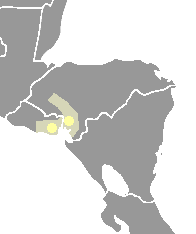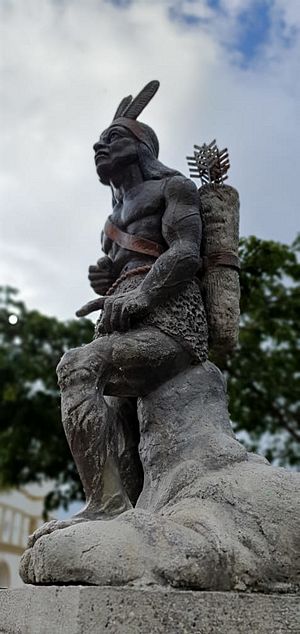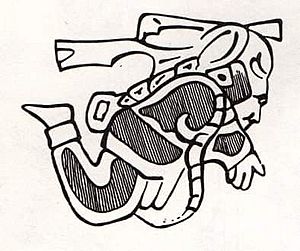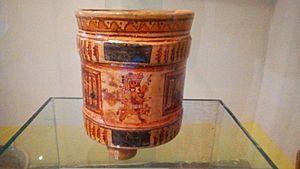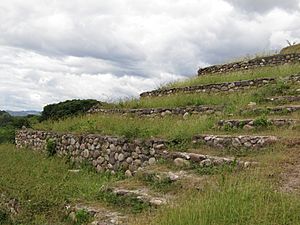Lenca facts for kids
 |
|
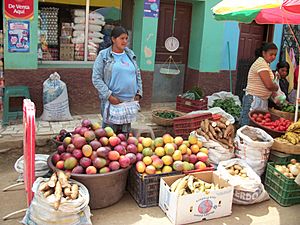
Lenca at a market in La Esperanza, Honduras
|
|
| Total population | |
|---|---|
| 450,000 | |
| Regions with significant populations | |
| Estimated 360,611 60% of the Indigenous Hondurans | |
| Estimated 89,389 | |
| Languages | |
| Honduran Spanish • Salvadoran Spanish • Formerly Lencan languages | |
| Religion | |
| Roman Catholic, Traditional tribal religion | |
The Lenca are an indigenous people from Central America. They live in southwestern Honduras and eastern El Salvador. The Lenca once spoke their own language, called Lenca. This language is now almost gone. In Honduras, the Lenca are the biggest group of native people. There are more than 450,000 Lenca people today.
Before the Spanish arrived, the Lenca often met with Mayan groups. They also met with other native peoples from Mexico and Central America. Experts still discuss where the Lenca people originally came from. Scientists are looking for old clues to learn more about the Lenca before the Spanish came.
Contents
History of the Lenca People
Ancient Lenca Times
For a very long time, the Lenca lived in areas that are now Honduras and El Salvador. An old site in El Salvador, called Quelepa, was a Lenca city. People lived there for many centuries. Another important Lenca place was Yarumela in central Honduras. This city was a big trading center for the Lenca. Other smaller Lenca towns were Tenampua and Los Naranjos.
The name "Lenca" was first used by an American explorer, Ephraim George Squier, in 1853. He heard people in Guajiquiro call their language by that name.
In the early 1500s, each Lenca group had its own leaders. These groups were divided into smaller areas called "manors." Each manor had a main leader. Four helpers worked with him to run the government. The leader's oldest child would take over after him.
Fighting was common between different Lenca manors. They also fought with groups who spoke other languages, like the Pipils or Mayans. They fought to get more land or to capture people. Sometimes, the Lenca groups would stop fighting for a while. They remembered these peaceful times with a special event called the Guancasco ceremony. Most Lenca people were farmers. They grew corn and lived in simple huts.
Spanish Arrival and Resistance
When the Spanish arrived, they tried to make the Lenca people become Catholic. Some Lenca groups fought against this change. Others accepted it more peacefully. During the Spanish conquest, only three Lenca leaders are named in old writings. They were Mota, Entepica, and Lempira.
Mota led Lenca leaders who defended the area around Gracias a Dios. Entepica was a leader from Piraera. Lempira organized a big fight against the Spanish. This fight lasted about twelve years. Lempira died in 1537.
When the Spanish arrived, there were many Lenca people. Some say there were 300,000 Lenca in the 1520s. By 1550, this number dropped to about 25,000. Lempira's rebellion in 1537-1538 gathered over 30,000 warriors. This shows there was a large population. However, diseases brought by the Europeans also caused many Lenca to die.
After Independence
Honduras became free from Spain in 1821. A new country was formed with its own laws. But these laws did not include native groups like the Lenca as full citizens.
Lenca People Today
Even though many Lenca now speak Spanish and are Catholic, they still keep parts of their old culture. In 1993, a Lenca leader named Berta Cáceres helped start a group. It was called the Civic Council of Popular and Indigenous Organizations of Honduras (COPINH). She worked hard for the rights of native people and to protect the environment.
In 2015, Berta Cáceres won a big award for her environmental work. She was sadly killed in March 2016. She is remembered in her country and around the world for her long fight for the environment and for the rights of native people in Honduras.
Lenca Culture and Traditions
Today, there are still challenges for native land rights in Central America. But the Lenca have kept many of their old traditions. Their native language is almost gone. Their culture has also changed over time because of Spanish influence. Still, the Lenca keep some traditional ways. They are proud to be native people. There are now programs and books to help bring back the Lenca language and culture.
Lenca Economy and Work
Modern Lenca communities often grow crops using a system called "milpa." Lenca men are farmers. They grow crops like coffee, cacao, tobacco, and different kinds of plantains. They also grow maize (corn), wheat, beans, squash, sugarcane, and chili peppers. In El Salvador, they also grow peanuts. In their communities, Lenca people usually work together on shared projects.
Governments in Honduras and El Salvador are starting to accept native rights more. But the Lenca still struggle to keep their land. In the 1990s, native activists formed groups. They asked the government for land ownership and native rights. There is less land for native people now. This is because laws favor big companies and farmers. Many Lenca men have to find jobs in nearby cities.
Many Lenca communities still have shared land. They grow most of their crops to sell to other countries. Most Lenca still use old farming methods for their own crops. They also use these methods for crops grown for investors.
Lenca Pottery and Crafts
Long ago, Lenca pottery looked like pottery from other groups in Mesoamerica. It was similar to Mayan pottery. Today, Lenca pottery looks very special. Lenca women make this pottery by hand. This traditional pottery is a unique part of their culture. Many handmade pieces are sold for high prices in other countries.
In the 1980s, groups of women artisans were formed. These groups helped sell their pottery. To sell more, they were told to make designs that city buyers would like. In the 21st century, Lenca women make modern painted pottery. It is often black and white. They do this to attract buyers from other countries.
Traditional Lenca pottery is still made by women in Gracias, Honduras and nearby villages. The pottery pieces are usually dark orange or brick colored. Visitors can watch how this traditional pottery is made.
Lenca Spirituality
Most Lenca people today are Roman Catholic. They became Catholic, sometimes by force, during the Spanish colonial period. Like other native groups, their religious practices often mix old traditions with Catholic ones. Some Lenca communities keep more of their native traditions.
Like other native peoples in Mesoamerica, the Lenca see sacred mountains and hills as holy places. Many Lenca deeply respect and worship the sun. Their main gods were Ilanguipuca (great father), Itanipuca (great mother), and Icelacam (god of time).
Some traditions are linked to growing and harvesting crops. For example, during different crop seasons, Lenca men take part in ceremonies. They drink a special drink called chicha and burn special incense.
The Guancasco Ceremony
The Guancasco is a yearly ceremony. Two nearby communities come together. They promise to be peaceful and friendly with each other. Guancascos have many forms. They often include Catholic symbols. But they also have old customs and traditions. People march in parades. They exchange special greetings. Honduran folk dances are performed for the statue of the town's patron saint. Towns in central and western Honduras, like Yamaranguila and La Campa, hold this yearly celebration.
Archaeological Discoveries
Until recently, not much archaeological research was done on Lenca sites. More attention was given to colonial-era towns influenced by Europeans. Also, many native sites are far away and hard to reach. It can also be hard for researchers to dig because the sites are often in farm fields. But clues on the ground show that native settlements existed in many areas long ago. Many old earth mounds have been damaged by farmers plowing their fields.
Clues about the ancient Lenca come from digging at several sites in Honduras and El Salvador. This research shows that Lenca communities grew steadily over time.
The Comayagua Valley in Honduras has many clues about Lenca settlements. It shows a rich history of different cultures meeting. Research in this area shows a complex history of about 2500 years. This goes from early ancient times to the Spanish Conquest in 1537. Old Lenca settlements were usually built near big rivers. This gave them water for drinking and travel. The lowlands were also good for farming.
The Lenca built few large public buildings. Most were made of adobe (mud bricks), not stone. They did build military forts.
In the Comayagua Valley, many artifacts show that Lenca towns were connected through pottery. The making of Usulua Polychrome pottery linked Lenca towns with nearby groups. Lenca sites like Yarumela and Los Naranjos in Honduras, and Quelepa in El Salvador, all have this type of pottery.
Yarumela is an important Lenca center. It was a large town, much bigger than other nearby settlements. It was likely chosen because it was close to fertile floodplains. These lands were good for farming. The way these old towns were set up suggests that Lenca society had different levels of importance.
Other sites, like Los Naranjos and Chalchuapa in El Salvador, have large earthen mounds. Many other sites seem to have similar layouts. They have big, flat open areas and large pyramid-shaped earth mounds.
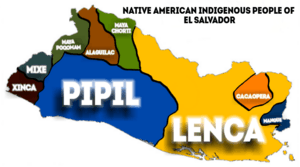
Quelepa is a major site in eastern El Salvador. Its pottery is very similar to pottery found in central El Salvador and the Maya highlands. Experts think that Lenca speakers from Honduras settled Quelepa. They might have moved there because their old lands became too crowded.
Since the late 1900s, experts have focused on studying how Lenca settlements were built. This helps them understand the timeline of Lenca life before the Spanish arrived.
Lenca Tourism and Culture
Tourism focused on Lenca heritage is growing. It helps people learn about Lenca traditions and culture, especially in Honduras. The Honduran Tourism Institute and the United Nations Development Program created a project. It is called La Ruta Lenca (The Lenca Route).
This tourist route goes through towns in southwestern Honduras. These towns are in traditional Lenca territory. The route has stops in different areas. These include La Campa, where Lenca women make traditional pottery by hand. It also includes the old sites of Los Naranjos and Yarumela. The town of Gracias and other towns with Lenca heritage are also on the route.
La Ruta Lenca was made to bring tourists to Lenca communities. It also helps keep native cultural practices alive. It does this by helping artisans earn more money and find new buyers for their crafts. The project has had some good results.
Protecting Lenca Lands and Environment
Lenca community members have become more involved in national issues. They work for human rights and land rights for native peoples. They see these two things as connected. They also work on environmental issues. They try to protect their lands from big development projects. These projects could change their land and nature. Speaking out can be dangerous. Some native people who oppose such projects have been killed.
Berta Cáceres was a very important Lenca leader. She helped start the Council of Popular and Indigenous Organizations of Honduras (COPINH). Cáceres strongly protested a dam project on the Gualcarque River in Honduras. This project was called the DESA Agua Zarca Hydro Project.
Berta Cáceres won the 2015 Goldman Environmental Prize for her work. She led environmental movements and helped the Lenca people. She was sadly killed at her home on March 3, 2016. After her death, major international investors stopped funding the Agua Zarca project.
Lesbia Yaneth was another Lenca activist. She opposed another hydroelectric project. Her body was found on July 7, 2016. Because she was active in COPINH, her friends believe she was killed for her political work. Officials from the United Nations and European Union protested her death.
Notable Lencas
- Lempira
- Berta Caceres
- Bertha Zúñiga
- Jona
- Johnny Leverón
See also
 In Spanish: Lenca para niños
In Spanish: Lenca para niños


